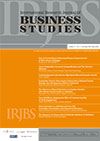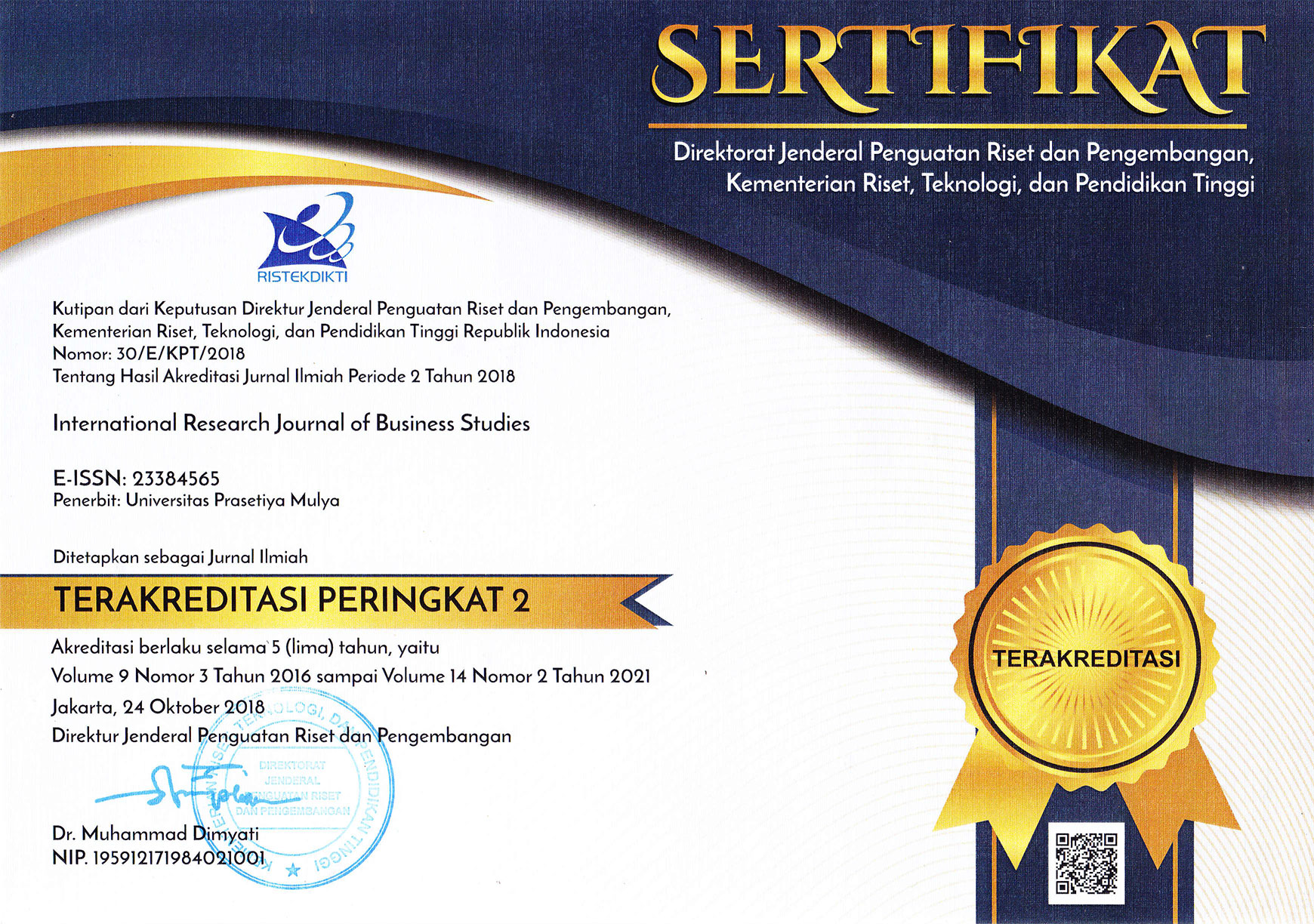The Role of Competencies and Education in Increasing Entrepreneurial Intention in Creative Economy
DOI:
https://doi.org/10.21632/irjbs.11.1.31-44Keywords:
entrepreneurial competencies, education level, creative economy, entrepreneurial intentionAbstract
The creative economy is being increasingly encouraged by the Indonesian government, the existing entrepreneurs are mostly engaged in the culinary industry. This study aims to describe the role of competencies and education in increasing entrepreneurial intention in the creative economy. Three hundred and five questionnaires were distributed to creative entrepreneurs, consisting of 162 respondents in Jakarta and 143 in Balikpapan using convenience sampling. Research findings show that there is no difference between the mean scores of entrepreneurial competencies in Jakarta and Balikpapan. Furthermore, the level of education has a positive effect on (i) entrepreneurial intention, (ii) entrepreneurial professional attraction, and (iii) entrepreneurial networking support. There is a positive relationship between education level and monthly revenue, as well as between entrepreneurial competencies and monthly revenue. The findings of this research would suggest government and education institution to further develop entrepreneurship education and train them with various methods and to cultivate interests in other creative sub-sectors.
References
Acho-Chi, C.(1998). Sustainable Self-Development Efforts in Cameroon Grass Fields. Development in Practice, Vol. 8, No. 3, pp. 366-371.
Ajzen, I. (1991). The theory of planned behavior. Organizational behavior and human decision processes. Vol. 50, 179-211.
Ajzen, I. Fishbein, M. (2005). Theory-based behavior change intervention: comments on hobbis and sutton. Journal of health psychology. Vol. 10, No.1, 27-31.
Alhaj, Baharu Kemat., Yosuf, Mohammed Zain., and Edama, Nita. (2011). Entrepreneurial Intention: An Empirical Study of Community College Students in Malaysia (harat Keusahawanan: Suatu Kajian Empirikal Mengenai Pelajar-Pelajar Kolej Komuniti di Malaysia). Jurnal Personalia Pelajar. Bil. 14 pp. 45-58
Badan Ekonomi Kreatif (Bekraft). (2017). Tonggak Baru ekonomi kretif Indonesia, Retrieved May 08 May 2017 www.bekraf.go.id/profil
Bhola, R., Verheul, I., Thurik, R., and Grilo, I. (2006). Explaining Engagement Levels of Opportunity and Necessity Entrepreneurs. Erasmus University Rotterdam.
Block, J., and Sandner, P. (2009). Necessity and Opportunity Entrepreneurs and their Duration in Self-Employment: Evidence from German Micro Data. Berlin.
Block, J.H., and Wagner, M. (2010). Necessity and Opportunity Entrepreneurs in Germany: Characteristics and Earning Differential. Journal of Schmalenbach Business Review, Vol 62 (April), pp. 154-174.
Callisen, L. (2015). 6 Soft Skills for Entrepreneurs: A Guide to Success.
Cooper, A.C. (1985). The Role of Incubator Organizations in the Founding of Growth-Oriented Firms. Journal of Business Venturing. Vol. 1, No. 1, pp. 75-86.
Cowling, M., and Bygrave, W.D. (2003). Entrepreneurship and Unemployment: Relationship Between Unemployment and Entrepreneurship in 37 Nations Participating in The Global Entrepreneurship Monitor (GEM) 2002. Frontiers of Entrepreneurship Research, pp. 544-555.
Crocker, L., & Algina, J. (2008). Introduction to classical and modern test theory. Mason, Ohio: Cengage Learning.
Enciety News. (2015). Potensi Industry Kreatif di Surabaya. Retrieved, 09 May 2017 www.enciety.co/potensi-industri-kreatifdi-surabaya/
Gartner, W.B., and Carter, N. (2003). Entrepreneurial Behavior and Firm Organizing Processes. Acs. Z.J., Audretsch., D.B., Handbook of Entrepreneurship Research, Kluwer, Boston, pp. 195-221.
Ikupolati, A.O., Adeyeye, M.M., Oni, E.O., Olatunle, M.A., Obafunmi, M.O., (2017). Entrepreneurs’Managerial Skills as Determinants for Growth of Small and Medium Enterprises (SMEs) in Nigeria. Journal of Small Business and Entrepreneurship Development. Vol 5., No. 1, pp. 1-6.
Kemenperin, Agustus (2015). Industri Kreatif Tumbuh 7% Per Tahun. Retrived 08 May 2017. http://www.kemenperin.go.id/artikel/12797/Menperin:-Industri-Kreatif-Tumbuh-7-Per-Tahun
Kerlinger, F.N. & Lee, H.B. (2000). Foundations of behavioral research (4th ed.). Australia: Wardsworth Thomson Learning.
Kolveraid, L., and Moen, O. (1997). Entrepreneurship Among Business Graduate: Does a Major in Entrepreneurship Make a Difference?. Journal of European Industrial Training, Vol. 21, No. 4, pp. 154-160.
Krueger, N, Jr.; Reilly, M.; Carsrud, A., (2000). Competing models of entrepreneurial intention. Journal of Business Venturing, V. 15, N.2, p. 177-194.
Mbogo, Marion., (2010). The Impact of Mobile Payments on the Success and Growth of Micro-Business: the Case of M-Pesa in Kenya. The Journal of Language, Technology & Entrepreneurship in Africa, Vol. 2, No. 1 pp. 182-203.
Mohammad, N., Lim, H.E., Yosuf, N., and Soon. (2015). Estimating the Effect of Entrepreneur Education on Graduates’ Intention to be Entrepreneurs. Emerald Group Publishing Limited. Vol. 57, No. 89, pp. 874-890.
Mosey, S., and Wright, M. (2007). From Human Capital to Social Capital: a Longitudinal Study of Technology-Based Academic Entrepreneurs. Entrepreneurship Theory and Practice, Vol. 31, pp. 909-935.
Mushtaq, H. Ahmad., Hunjra, Ahmed Imran., Niazi, G.S.K., Rehman, Kashif-Ur., Azam, Rauf I. (2011). Planned Behavior Entrepreneurship and Intention to Create a New Venture Among Young Graduates. Journal Management & Marketing Challenge for the Knowledge Society, Vol.6, No.3, pp.437-456.
Pro Kaltim, (2016). Jadi Wadah Bagi Pelaku Ekonomi Kreatif. Retrieved May 02, 2016. http://kaltim.prokal.co/read/news/286100-jadi-wadah-bagi-pelaku-ekonomi-kreatif.html
Rahman, M.A.(1993). People’s Self-Development: Perspectives on Participatory Action Research, Zed Books. London and New Jersey.
Reynolds, P.D., Camp, S.M., Bygrave, W.D., Autio, E., and Hay, M. (2001). Global Entrepreneurship Monitor 2001 Executive Report.
Riyanti, B.P.D., Sandroto, C.W., and Warmiyati, M, T. (2016). Soft Skill Competencies, Hard Skill Competencies, and Intention
to Become Entrepreneur of Vocational Graduates. International Research Journal of Business Studies. Vol.9, No. 2, pp. 119-132.
Scarboroug, Norman M., and Cornwall, Jeffrey R. (2016). Essentials of Entrepreneurship and Small Business Management. 8thed. Boston: Pearson Global Edition.
Shapero, A; Sokol. L. (1982). Social dimension on entrepreneurship. In Kent, C.A, Sexton, & Vesper, K.H., Eds. Encyclopedia of entrepreneurship. Englewood Cliffs (NJ): Prentice Hall.
Shermon, G. (2004). Competency-Based HRM: A Strategic Resource for Competency Mapping, Assessment and Development Centres. Tata McGraw-Hill
Spencer, L.M.& Spencer, S.M. (1993). Competence at work. Toronto: John Wiley & Sons, Inc.
Stephan, Ute., and Uhlaner, Lorraine M. (2010). Performance-Based vs Socially Supportive Culture: A Cross-National Study of Descriptive Norms and Entrepreneurship. Journal of International Business Studies, Vol.41, pp. 1347-1364.
Tian, Yuan., Gao, Changchun., (2011): Management Strategies of Creative Industries Uncertainty, IEEE Journal 978-0-7695-4464-9/11.
Verheul, I., Thurik, R., Hessels, J., and Zwan, P.Van Der. (2010). Factors Influencing the Entrepreneurial Engagement of Opportunity and Necessity Entrepreneurs. Scientific Analysis of Entrepreneurship and SMEs, (March), 1-26
Wang, Xia0xia., Peng, Ren., (2009): The Creative Industry has come, IEEE Journal 978-1-4244-5268-2/09
Downloads
Submitted
Published
How to Cite
Issue
Section
License
Copyright (c) 2018 Christine Winstinindah Sandroto, Yussi Ramawati, Syarief Darmo

This work is licensed under a Creative Commons Attribution-ShareAlike 4.0 International License.
Journal Author(s) Rights
For IRJBS to publish and disseminate research articles, we need publishing rights (transferred from the author(s) to the publisher). This is determined by a publishing agreement between the Author(s) and IRJBS. This agreement deals with the transfer or license of the copyright of publishing to IRJBS, while Authors still retain significant rights to use and share their own published articles. IRJBS supports the need for authors to share, disseminate and maximize the impact of their research and these rights, in any databases.
As a journal Author, you have rights to many uses of your article, including use by your employing institute or company. These Author rights can be exercised without the need to obtain specific permission. Authors publishing in IRJBS journals have comprehensive rights to use their works for teaching and scholarly purposes without needing to seek permission, including:
- use for classroom teaching by Author or Author's institution and presentation at a meeting or conference and distributing copies to attendees;
- use for internal training by the author's company;
- distribution to colleagues for their research use;
- use in a subsequent compilation of the author's works;
- inclusion in a thesis or dissertation;
- reuse of portions or extracts from the article in other works (with full acknowledgment of the final article);
- preparation of derivative works (other than commercial purposes) (with full acknowledgment of the final article);
- voluntary posting on open websites operated by the author or the author’s institution for scholarly purposes,
(But it should follow the open access license of Creative Common CC-by-SA License).
Authors/Readers/Third Parties can copy and redistribute the material in any medium or format, as well as remix, transform, and build upon the material for any purpose, even commercially. Still, they must give appropriate credit (the name of the creator and attribution parties (authors' detail information), a copyright notice, an open access license notice, a disclaimer notice, and a link to the material), provide a link to the license, and indicate if changes were made (Publisher indicates the modification of the material (if any) and retain an indication of previous modifications.
Authors/Readers/Third Parties can read, print and download, redistribute or republish the article (e.g. display in a repository), translate the article, download for text and data mining purposes, reuse portions or extracts from the article in other works, sell or re-use for commercial purposes, remix, transform, or build upon the material, they must distribute their contributions under the same license as the original Creative Commons Attribution-ShareAlike (CC BY-SA).
This work is licensed under a Creative Commons Attribution-ShareAlike 4.0 International License.








